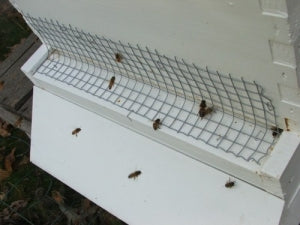
Preparing for Autumn
David MullinsShare
The leaves are turning and there's a chill in the air - autumn is here! While we enjoy hayrides, bonfires, apple cider, and our freshly harvested honey, it's also time to prepare the hives for the changes in weather. Autumn means mice! Just like they do in barns, patio grills, and houses, mice love to build nests in beehives. The bees are beginning to cluster together in the shape of a football in the center of the hives this time of year when it gets cold, and the mice can set up shop in the bottom of the hives. They leave during the day when it's warm and return in the cold when the bees are less active and clustered together. Eventually, it will be cold enough that the bees will stay clustered, and the mice will live out the winter eating honey, dead bees, and staying warmer in their nests due to the heat generated by the clustered bees.
So, we at Bee Great remain vigilant in protecting our hives from invading mice. There are many mouse guards available to put on the entrance of beehives, but we use simple half inch hardware cloth. Putting the hardware cloth over the entrance allows the bees to come and go from the hive, but it inhibits mice from entering and building a nest. Additionally, we find that keeping the entrance open with the hardware cloth through the winter months allows for better ventilation for the bees. The increased ventilation reduces the build-up of moisture in the hive, which is what kills colonies of bees in our area of Indiana. Think of the condensation that forms on the windows of your home inside during the winter months and how the water drips down and rots the window sill. The same is true for beehives because the bees maintain their temperature in the cluster and the heat rises to the inside of the cover, condenses into water when it comes in contact with the cold cover, and then the water drops back down on the bees. Keeping the entrance open allows for better airflow and the other techniques we use to winterize the beehives help reduce condensation from forming on the inside of the cover. It little hard work on our part, and the bees stay warm, dry, and free of mice all winter long!
Shop Now to help us protect the bees!
